
- ARAB NEWS
- 01 Aug 2025

ABU DHABI: Renowned Japanese architect Riken Yamamoto, recipient of the 2024 Pritzker Architecture Prize, is redefining the role of architecture in fostering community and social cohesion.
Speaking at a special talk as part of the Abu Dhabi Festival 2025 in collaboration with New York University Abu Dhabi, Yamamoto shared insights into his human-centered design philosophy and his vision for the future of architecture.
For Yamamoto, winning the Pritzker Prize is more than a personal achievement.
“Creating a vibrant local community with autonomy and passing that vision on is my responsibility as a Pritzker Prize laureate,” he told Arab News Japan.
His interest in socially responsive architecture was sparked during his university years in Japan, a period marked by student protests and urban research under Professor Hiroshi Hara at the Institute of Industrial Science, The University of Tokyo.
He said these experiences laid the foundation for his approach to architecture, which extends beyond buildings to entire urban ecosystems.
Yamamoto’s work is focused on sustainable practices.
“Architecture should serve the local community,” he explained. “By fostering a sense of belonging and continuity, sustainable architecture ensures prosperity for future generations.”
One of Yamamoto’s most acclaimed projects, the Pangyo Housing complex in South Korea, showcases his ability to blur the lines between public and private spaces.
Designed to encourage resident autonomy and interaction, the project showcases how architecture can create inclusive environments that support community engagement.
As the world grapples with the challenges of aging populations, Yamamoto advocates architecture that facilitates social support networks.
“Communities help address the challenges of an aging society,” he said. “If we create good models, they will serve as positive examples for the international community.”
His expertise in disaster resilience further underscores the role of architecture in societal well-being. He believes that well-designed communities can strengthen local responses to disasters and aid in long-term recovery efforts.
In the future, Yamamoto said he expects cities to shift away from high-rise buildings, which he sees as costly to maintain and lacking in community spirit.
Instead, he predicts a growing interest in underground architecture, particularly in hot climates like the UAE, where subterranean spaces provide natural temperature stability and energy efficiency.